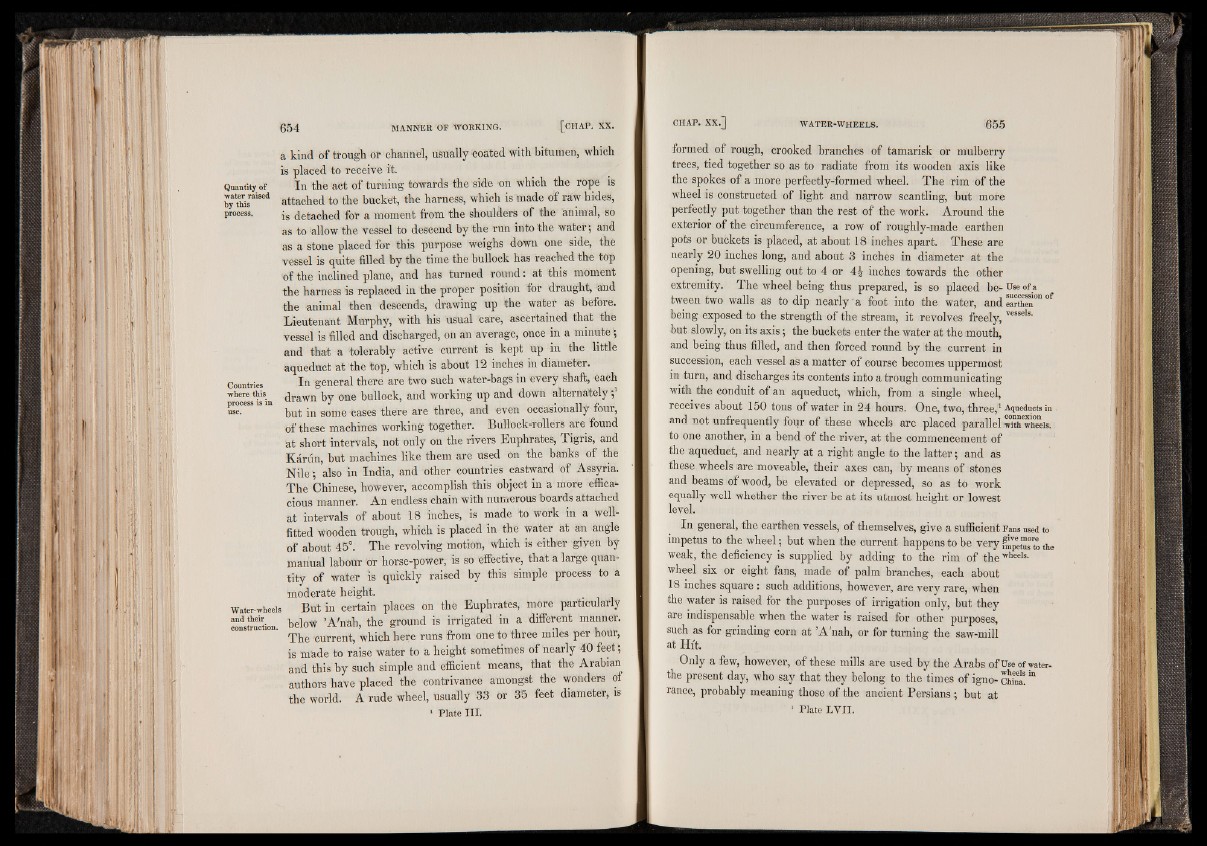
a kind of trough or channel, usually coated with bitumen, which
is placed to receive it.
Quantity of In the act of turning towards the side on which the rope is
byteriW attaclied t0 the bucket, the harness, which is made of raw hides,
process. ¡s detached for a moment from the shoulders of the animal, so
as to allow the Vessel to descend by the run into'the water ; and
as a stone placed for this purpose weighs down one Side, the
vessel is quite filled by the time the bullock has reached the top
of the inclined plane, and has turned round : at this moment
the harness is replaced in the proper position for draught, and
the animal then descends, drawing up the water as before.
Lieutenant Murphy, with his usual Care, ascertained that the
vessel is filled and discharged, on an average, once in a minute ;
and that a tolerably active current is kept up in the little
aqueduct at the top, which is about 12 inches in diameter.
Countries In general theré are two such water-bags in every shaft, each
■where this ¿rawn bv one bullock, and working up and down alternately1;1
process is in « _ • 11 l r use* but in some cases there are three, and even occasionally tour,
of these machines working together. Bullock-rollers are found
at short intervals, not only on the rivers Euphrates, Tigris, and
Kàrun, but machines like them are used on the banks of the
Nile '; also in India, and other countries eastward of Assyria.
The Chinese, however, accomplish this object in a more efficacious
manner. An endless chain with numerous boards attached
at intervals of about 18 inches, is made to work in a Well-
fitted Wooden trough, which is placed in the water at an angle
of about 45°. The revolving motion, which is either given by
manual labour or horse-power, is so effective, that a large quantity
of water ÌS quickly raised by this simple process to à
moderate height.
Water-wheels Butin certain places on thè Euphrates, more particularly
and their below ’A'nàh, the ground is irrigated in a different manner. construction. UC1U VY °
The current, which here runs from one to three miles per hour,
is made to raise water to a height sometimes of nearly 40 feet ;
and this by such simple and efficient means, that the Arabian
authors have placed the contrivance amongst the wonders of
the world. A rude wheel, usually 33 or 35 feet diameter, is
1 Plate I I I .
formed of rough, crooked branches of tamarisk or mulberry
trees, tied together so as to radiate from its wooden axis like
the spokes of a more perfectly-formed wheel. The rim of the
wheel is constructed of light and narrow scantling, hut more
perfectly put together than the rest of the work. Around the
exterior of the circumference, a row of roughly-made earthen
pots or buckets is placed, at about 18 inches apart. These are
nearly 20 inches long, and about 3 inches in diameter at the
opening, but swelling out to 4 or 4£ inches towards the other
extremity. The wheel being thus prepared, is so placed be- Use of a
tween two walls as to dip nearly a foot into the water, and earthen01* °f
being exposed to the strength of the stream, it revolves freely* vessels'
but slowly, on its axis; the buckets enter the water at the mouth,
and being thus filled, and then forced round by the current in
succession, each vessel as a matter of course becomes uppermost
in turn, and discharges its contents into a trough communicating
with the conduit of an aqueduct, which, from a single wheel,
receives about 150 tons of water in 24 hours. One, two, three,1 Aqueducts in
and not unfrequently four of these wheels are placed parallel S ' X k
to one another, in a bend of the river, at the commencement of
the aqueduct, and nearly at a right angle to the latter; and as
these wheels are moveable, their axes can, by means of stones
and beams of wood, be elevated or depressed, so as to work
equally well whether the river be at its utmost height or lowest
level.
In general, the earthen vessels, of themselves, give a sufficient Fans used to
impetus to the wheel; but when the current happens to be very impetust» the
weak, the deficiency is supplied by adding to the rim of thewheels-
wheel six or eight fans, made of palm branches, each about
18 inches square : such additions, however, are very rare, when
the water is raised for the purposes of irrigation only, but they
are indispensable when the water is raised for other purposes,
such as for grinding corn at ’A'nah, or for turning the saw-mill
at Hit.
Only a few, however, of these mills are used by the Arabs ofUseofwater-
the present day, who say that they belong to the times of igno- riS*
ranee, probably meaning those of the ancient Persians ; but at
1 Plate L Y II.